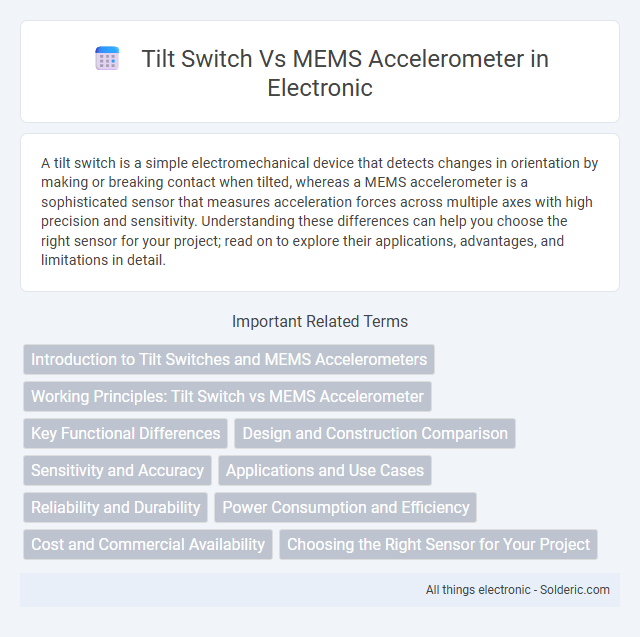A tilt switch is a simple electromechanical device that detects changes in orientation by making or breaking contact when tilted, whereas a MEMS accelerometer is a sophisticated sensor that measures acceleration forces across multiple axes with high precision and sensitivity. Understanding these differences can help you choose the right sensor for your project; read on to explore their applications, advantages, and limitations in detail.
Comparison Table
| Feature | Tilt Switch | MEMS Accelerometer |
|---|---|---|
| Function | Detects tilt by triggering at a specific angle | Measures acceleration and orientation in multiple axes |
| Output | Digital (on/off switch) | Analog or digital multi-axis data |
| Axes of Measurement | Single axis | 3-axis (X, Y, Z) |
| Precision | Low; simple threshold detection | High; detailed angle and motion data |
| Response Time | Fast switching response | High-speed data sampling |
| Size | Small, mechanical component | Very small, integrated circuit |
| Durability | Mechanical wear possible | Solid-state, highly durable |
| Power Consumption | Very low | Moderate to low |
| Cost | Low cost | Higher cost |
| Applications | Basic tilt detection, safety switches | Motion sensing, navigation, gesture recognition |
Introduction to Tilt Switches and MEMS Accelerometers
Tilt switches are electromechanical devices that detect orientation or inclination by opening or closing an electrical circuit based on the position of a conductive element inside a housing. MEMS accelerometers use microelectromechanical systems technology to measure acceleration forces and can detect changes in velocity, tilt, and vibration with high precision. While tilt switches provide simple binary tilt detection, MEMS accelerometers offer multi-axis measurement and greater sensitivity for advanced motion sensing applications.
Working Principles: Tilt Switch vs MEMS Accelerometer
A tilt switch operates using a simple mechanical mechanism where a conductive ball or pendulum completes an electrical circuit when tilted beyond a certain angle, enabling detection of orientation changes. In contrast, a MEMS accelerometer relies on microelectromechanical systems technology that measures acceleration forces along multiple axes by detecting displacement of a micro-scale proof mass suspended within the sensor. MEMS accelerometers provide precise, multi-axis acceleration data for dynamic motion and tilt detection, while tilt switches offer a cost-effective, single-threshold orientation sensing solution without complex signal processing.
Key Functional Differences
Tilt switches detect orientation changes by physically opening or closing a circuit when tilted beyond a specific angle, providing simple binary outputs ideal for basic on/off applications. MEMS accelerometers measure acceleration forces across multiple axes with high precision, enabling detection of dynamic motion, vibration, and tilt with digital output for complex analysis. Your choice depends on whether you need straightforward tilt detection or detailed, multi-axis motion measurement with advanced data processing.
Design and Construction Comparison
Tilt switches consist of a simple mechanical design with a movable internal component that closes an electrical circuit when tilted, offering low cost and straightforward operation. MEMS accelerometers utilize microelectromechanical systems technology with tiny capacitive plates that detect acceleration forces in multiple axes, providing precise and multi-directional measurements. Your choice depends on whether you need basic tilt detection or advanced, high-resolution acceleration sensing.
Sensitivity and Accuracy
Tilt switches offer basic sensitivity by detecting changes in position through simple mechanical movement, making them suitable for applications requiring on-off state detection rather than precise angle measurement. MEMS accelerometers provide high sensitivity and superior accuracy by measuring acceleration forces with microelectromechanical systems, enabling detection of minute tilt variations and dynamic motion. Your choice depends on the need for precise angular data, where MEMS accelerometers outperform tilt switches in both sensitivity and accuracy.
Applications and Use Cases
Tilt switches are commonly used in simple orientation detection applications such as alarm systems, safety devices, and appliance controls where basic on/off position sensing is sufficient. MEMS accelerometers provide precise multi-axis motion and vibration sensing, enabling advanced applications like smartphone screen rotation, vehicle stability control, and fitness tracking in wearable devices. Your choice depends on the complexity and accuracy required, with MEMS accelerometers offering versatile solutions for dynamic and detailed movement analysis.
Reliability and Durability
Tilt switches offer simple, mechanical reliability with fewer components prone to failure, making them highly durable in harsh environments and long-term applications. MEMS accelerometers provide precise motion detection but can be sensitive to environmental factors like temperature fluctuations and vibration, potentially affecting their lifespan and reliability. Your choice depends on whether consistent robustness or advanced sensitivity is paramount for your application.
Power Consumption and Efficiency
Tilt switches consume minimal power, often operating passively without a continuous energy draw, making them highly efficient for simple orientation detection tasks. MEMS accelerometers require an active power supply to function, with consumption varying based on measurement range and sampling frequency, generally resulting in higher energy use compared to tilt switches. Your choice depends on whether you prioritize ultra-low power consumption for basic tilt sensing or detailed motion data with some trade-off in energy efficiency.
Cost and Commercial Availability
Tilt switches are cost-effective and widely available commercial components, making them ideal for simple applications where budget constraints are critical. MEMS accelerometers, though more expensive, offer advanced functionality and precision, and their commercial availability has increased significantly with innovations in microelectromechanical systems technology. Your choice depends on balancing the lower cost and accessibility of tilt switches against the versatile capabilities and growing market presence of MEMS accelerometers.
Choosing the Right Sensor for Your Project
Selecting between a tilt switch and a MEMS accelerometer depends on your project's precision and complexity requirements. Tilt switches offer simple on/off detection for angular position with low power consumption, ideal for basic orientation sensing. MEMS accelerometers provide detailed multi-axis acceleration data, enabling advanced motion analysis and precise tilt measurement for sophisticated applications.
tilt switch vs MEMS accelerometer Infographic

 solderic.com
solderic.com